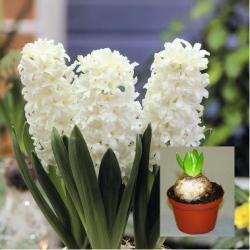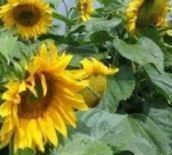Tag Archive: flowers
Rosa Pascali, Rosa Margaret Merrill and Crocus Ruby Giant
 This morning was a little milder and so I planted a new rose, Rosa Pascali, alongside the chicken enclosure. There is already a rose there, Rosa Margaret Merrill, which has been in the garden for a couple of years. Both are white and both are scented so they should look good in front of the new Clematis I put in recently.
This morning was a little milder and so I planted a new rose, Rosa Pascali, alongside the chicken enclosure. There is already a rose there, Rosa Margaret Merrill, which has been in the garden for a couple of years. Both are white and both are scented so they should look good in front of the new Clematis I put in recently.
Pascali was bred in Belgium and introduced in 1963. Like its parent, Queen Elizabeth, it presents one fragrant, creamy-white bloom per stem. It is a modern bush rose that grows into a sturdy, upright plant and has pointed blossoms well suited for cutting, blooming continuously or in flushes all season.
Rosa Margaret Merrill has delicate, double, exceptionally fragrant, pale pink to white flowers from July to September and crisp, dark green leaves. This vigorous, cluster-flowered bush rose is perfect for an open, sunny site with fertile, moist, well-drained soil. Offering good resistance to disease, the beautiful high-centred to cup-shaped blooms make excellent cut-flowers.
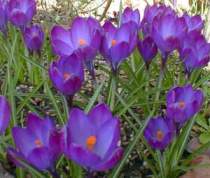 I also divided fifty Crocus Ruby Giant between two pots
I also divided fifty Crocus Ruby Giant between two pots
Crocus tommasinianus Ruby Giant was introduced in 1956 and is rich reddish purple with yellow-orange anthers. It will naturalise readily. Bred in Holland, even when closed, the sturdy stems hold the flower heads up above their leaves. It will flower early in Spring, and is attractive to insects. While needing a well-drained position and loving the sun, it is more happy in shade than most crocuses. Its capacity for spreading means it will establish itself wherever it is put.
Galanthus Nivalis – Snowdrop
The Common Snowdrop – They are extraordinarily hardy and can be depended on to flower very early whatever the weather, the colder and gloomier it is, the longer the blooms last. Best planted in light shade. They will grow in most soils but make the best plants in heavier moist conditions. They are most successfully transplanted while growing in the green. Bulbs often take a season to settle down before flowering.
I have planted up some Snowdrops in the big blue pot by the back door. I have planted these before in the area around the pond but they were spoiled by the ducks and the chickens as soon as they popped their green shoots through the soil. I am hoping that they will have a fighting chance to multiply in the pot and then I will make another attempt to put some in the garden. We only have the two ducks and little YuYu the minature Silkie in the garden now as the bulk of the chickens are restricted to the trellised off area.
We made a quick visit to the plots this morning to take the chicken poo. We put it all on the top of the bean trench hoping that the worms will dig it in for us. I finally put the Dahlias to bed by cutting them off at about two inches above ground then covering them with straw to protect them from the wet and the frost. They really needed digging up and splitting this year but we just haven’t had time.
Sunflower Giant
Libbie is 3
It is Libbie’s third birthday so we went to take her presents over. She is so beautiful and really bright. We are so proud of her.
When we came home we got changed and spent an hour at the plots. Rob planted two rows of potato Rocket on plot 18 and I planted some Dhalia corms Graceful Mix and a root of Gypsophilia in the flower bed on plot 8. I collected a good sized bag of sprouts to bring home and the rest of the time was spent pulling up plants past their best and tidying beds ready for new planting.
Meconopsis Grandis – Himalayan Blue Poppy 2008

I have bought a few plants in the past of the Himalayan Blue Poppy but never had one survive in my garden. I have been doing a bit of research on the internet and have been amazed at how many cultivars, I think thats the right word, there are of this beautiful flower. Not being too hopeful and not wanting to spend too much on seeds I ordered Meconopsis Grandis from Alan Romans and have today sown them in moist compost, covered the tray in a polythene bag and sat it on the computer box. The seed pack had been sitting in the fridge for two days. My research brought forth much conflicting advice about how to raise these plants from seed and after looking at the pictures I am determined to get hold of some Meconopsis Bobby Masterton and Meconopsis Mrs Jebb as they look truly wonderful.
Here are a few bits of advice I found. Store seed in a sealed container in a domestic fridge. Commercial seeds sometimes appear to be less viable than home-collected seeds. The type of compost used for seed germination is not too critical. A peat-based one is most usually used. An important feature is for it to have high air porosity. The incorporation of a lot of grit enabling minimum root damage when pricking out is also preferable. Sow seed in Dec – Feb onto the surface of moist compost in trays or plastic pots. Water the pots from below and avoid seed disturbance. Either leave uncovered, but more usually growers cover the seed with several mm of fine grit or a little sieved compost. Keep in a light place, usually a cool greenhouse. Sometimes pots are placed on a heated bench (around 15C), or out-of-doors. Never allow surface to dry out, especially after germination has taken place. Germination takes two weeks to several months, sometimes occurring in the second year. Damping-off can be a problem. Prick out seedlings at the two or three leaf-stage. Avoid damaging the stem, by handling the leaves only. Transfer gently to the same light compost, avoiding compaction. Keep in a shady place until growth has resumed. Keep the plants growing actively, and repot before the pots become root-bound. It is important not to let the plants suffer a check in growth. Transfer to larger pots or into the garden when large enough. Depending on climate this is summer, late summer-autumn or the following spring. You can see why I am confused.
Impatiens F2 Colour Magic
 This morning I have sown 24 Busy Lizzie seeds in a modular propagation tray and they are now sitting on the window ledge. I have often bought these from the garden centre as small plants but have never grown them from seed. I haven’t seen this particular variety before. They were bought from Alan Romans at 50p for 85 seeds.
This morning I have sown 24 Busy Lizzie seeds in a modular propagation tray and they are now sitting on the window ledge. I have often bought these from the garden centre as small plants but have never grown them from seed. I haven’t seen this particular variety before. They were bought from Alan Romans at 50p for 85 seeds.
This compact variety is early flowering and very tolerant of shade. The flowers are large and come in a cheery mix of orange, pink, carmine, scarlet and white. Ideal for beds and borders or to brighten up a shady spot on the patio.
Rudbeckia x hirta hybrida ‘Cherokee Sunset’ (HHA)
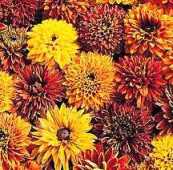 Today I have sown some seeds of Rudbeckia bought from Alan Romans 50p for 50 seeds. I needed a bit of cheering up after the week we have had which I won’t go into but suffice it to say has been awful. My Mother always used to tell us to count our blessings so we will have to start totting up and cheering up.
Today I have sown some seeds of Rudbeckia bought from Alan Romans 50p for 50 seeds. I needed a bit of cheering up after the week we have had which I won’t go into but suffice it to say has been awful. My Mother always used to tell us to count our blessings so we will have to start totting up and cheering up.
That’s Easy
It is easy enough to be pleasant when life flows by like a song
But the man worthwhile is one who will smile when everything goes dead wrong
By : Ella Wheeler Wilcox 1850-1919
Growing Nasturtium in The Salad Bed – Allotment 2008
Last year I grew Nasturtium along the edges of the salad bed. I sowed them directly into the ground and was overwhelmed by how vigorously they eventually grew. Unfortunately they stifled the smaller plants and moved over to cover the corn bed too. As the corn was high they survived and may even have benefitted from the moisture that was not lost because the Nasturtium shaded the ground between the corn plants. I saved loads of seed at the end of the season. This year I want to be a bit more in control and so have sown a tray indoors. I shall probably sow some seeds over in the hedge on plot 18 as it is all brambles and hawthorne at present not to mention a fair bit of rubble and bricks so I hope that they will mask it a little.
Sow directly March-May, flowers June-September. Nasturtiums flower abundantly in poor soil and transform hot, dry places into a blaze of colour. Flowers are edible, and ideal for use in salads.
Columbine – Aquilegia Vulgaris
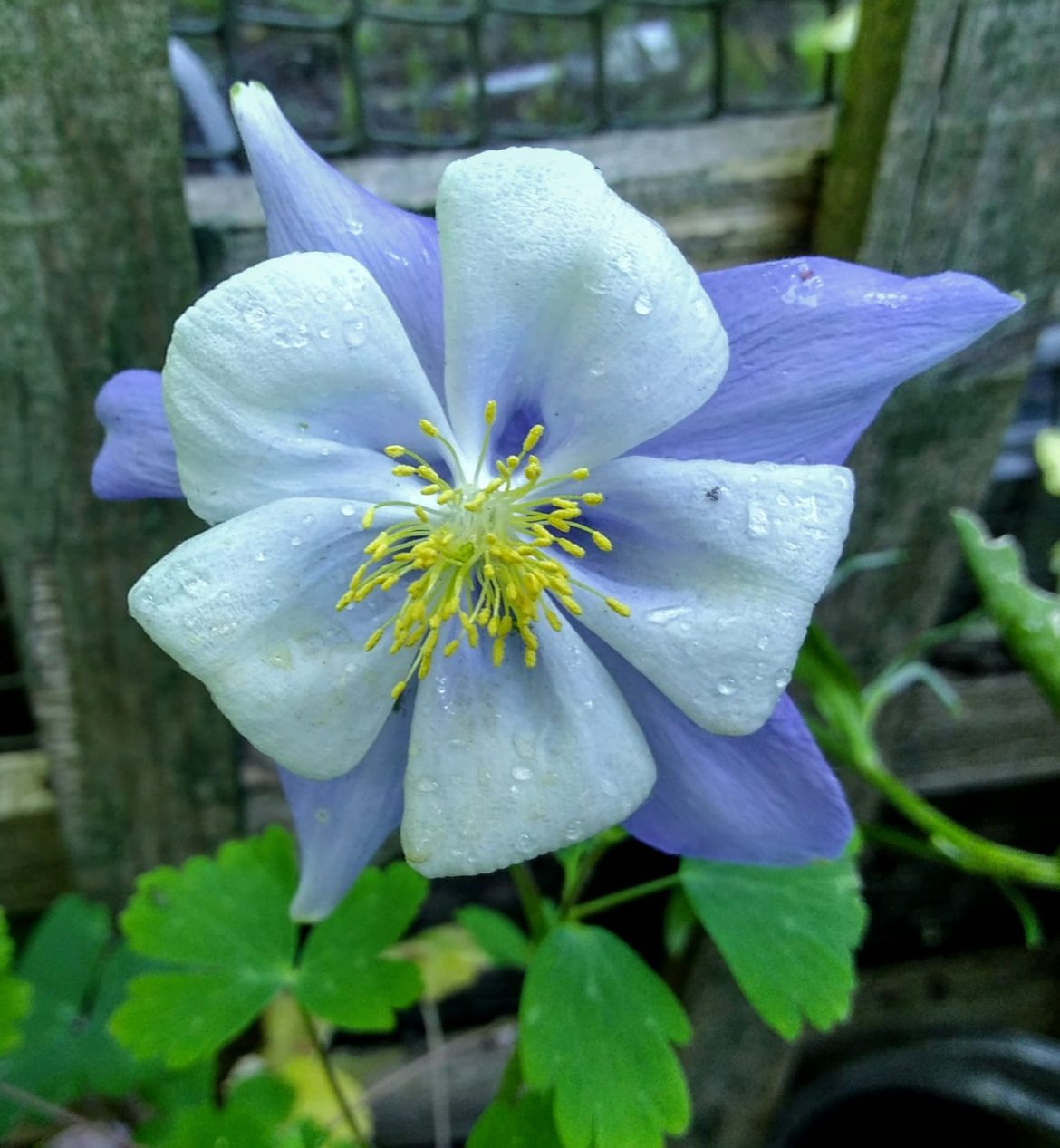
This morning I have sown a tray of Aquilegia seeds in damp compost and covered in Vermiculite, sealed in polythene and placed in the window ledge. I am not sure of variety as they were given to me by my Sister-in-law Janice and were given to her by her Mother Joyce who had collected them from her garden. Apparently they take 25-35 days to germinate and we wont see any flowers from them until next Spring. It will be worth the wait though as they are perennials and once established should give us pleasure for many years. I intend to scatter a few seeds directly along the back border at home and see what I can get there. I have always admired these beautiful flowers but have never tried to grow them from seed before.
Aquilegia common names Granny’s Bonnet or Columbine is a genus of about 60-70 species of perennial plants that are found in meadows, woodlands, and at higher altitudes throughout the Northern Hemisphere, known for the spurred petals of their flowers.
